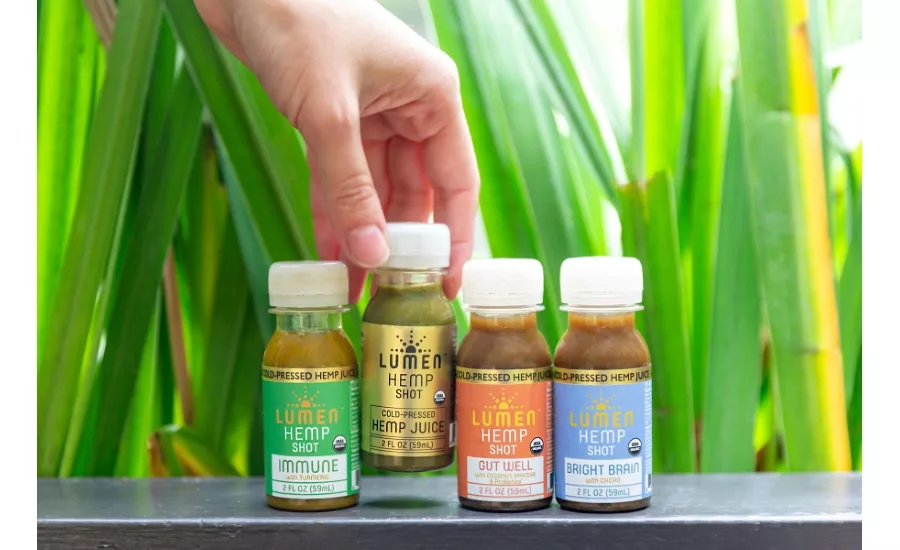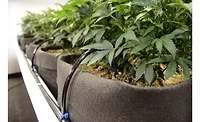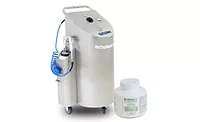QA/QC and process validation in cannabis edibles and beverages production

Lumen, the only USDA certified organic hemp wellness shot in the U.S.
Product line includes Immune, Gold Shot, Gut Well and Bright Brain. Courtesy of Lumen
Cannabis edibles and beverages production, although still a growing industry, needs to have its own set of quality assurance (QA) and quality control (QC) regulations. These regulations will make the sure the consumer, aka the end user, is happy with the product, and also is safe in ingesting it.
Quality assurance and quality control issues
Lezli Engelking, founder, Foundation of Cannabis Unified Standards (FOCUS), Scottsdale, AZ, says that ultimately, issues around quality assurance and quality control in the cannabis industry are due to the human element.
“Most operators are not familiar with food safety requirements or quality standards, nor do they understand their critical importance. This, combined with the lack of understanding of cannabis at the state regulatory levels, results in employees not receiving adequate training to properly control for quality and safety in the first place,” she explains.
This is true in cannabis growing, manufacturing, and retail operations, as well as in third party testing laboratories, Engelking adds, since cross contamination is rampant, and verification and validation are close to nonexistent.
Yasir Hashim, co-founder and CEO, Lumen, Santa Monica, CA, says that when developing a product, it’s important to look at cannabis and hemp as an ingredient like any other.
“The quality assurance and quality control measures required in the development of hemp and cannabis infused foods and beverages is very much the same to any other food or beverage,” he says. “The key things to watch out for are heavy metals, residual solvents and microbial contaminants that are easy to identify with third party testing.”
Looking for quick answers on food safety topics?
Try Ask FSM, our new smart AI search tool.
Ask FSM →
“Cannabis and hemp products that are certified organic, grown to organic standards or even beyond organic standards can ensure that there is a reduced risk to finding contaminants and a higher faulty end product for the consumer. Also, if you’re going to be making claims on our product, then third party testing to ensure accurate cannabinoid levels is critical,” Hashim explains.
Matthew Anderson, CEO, Vanguard Scientific, Aurora, OR, says that the simplest answer to QA/QC issues is to “build with the future in mind.”
“As federal and international standards for consumable ingredients grapple with how to harmonize best practices for consumer safety, our Quality Team is heavily focused on deploying a variety of QMS [Quality Management System] products that meet the operator where they are today and encourage improved conformance to uniform operating procedures moving forward,” he says.
“We’re of the opinion that Active Pharmaceutical Ingredients (APIs) will define the minor-cannabinoid opportunity. With major players like GW Pharmaceuticals laying the foundational clinical trial work for CBD (and thereby all cannabinoids as small molecule drugs or APIs), we see the inevitability of rapid and rigorous up-regulation of all American CB(X) supply-chain participants. The CPG or pharma buyer wanting to purchase or manufacture cannabinoids for formulated products will be bound by strict mandates for procurement guidelines from regulators,” Anderson notes.
As with the nutraceutical industry, ahead of federal regulation and enforcement, you’ll see supply-chain participants opting-in to higher levels of quality control/cGMP standards as a means of commercial competition, he finishes.
Mike Hennesy, director of innovation, Wana Brands, Boulder, CO, says that If you’re making an edible, then you’re making food for people to consume—aka, you need to be following good manufacturing practices (GMP), including safe food handling, clean facilities, and PPE for your staff.
“Quality assurance is also an integral piece of your plan, monitoring your operations for product issues like microbials, mold, ingredient degradation and expiration. When working with ingredients derived from cannabis, you also want to monitor for pesticides and heavy metals. Both CBD and THC products share these concerns,” he adds.
Cannabis is different from other crops when it comes to pesticides, Hennesy notes.
“What might be a safe amount of pesticide to use on an apple orchard, for example, doesn’t necessarily apply to cannabis due to how the plant is processed and extracted. On the front end, you’ll want to build a strong relationship with your grower to understand what pesticides are being used, how much is being used, and to ensure it’s legal for use on cannabis. On the back end, make sure your QA department is monitoring pesticide test results since that might give an early warning that levels are too high for the plant to be processed. The QA department should also monitor testing of the extract itself for pesticides to ensure levels are below allowable safe limits,” he recommends.
Heavy metals are also a concern, he says.
“Hemp is sometimes referred to as a sponge and has been grown on industrial waste sites to pull out contaminants from the soil. While this characteristic is useful for remediation, it can create challenges for food producers using THC or CBD extracts in their products,” Hennesy explains.
If you’re using plants from a grow located on soil contaminated with heavy metals, those contaminants may end up in the plants and your extract as well, he adds.
“For that reason, it is essential to know where your hemp comes from. Sources outside of the United States, such as Europe and China, lack the same regulations and oversight, creating a higher risk that you’ll end up with a product with high levels of heavy metals,” he comments.
“We’ve talked about what you don’t want in your product. It’s just as important to know what is in your extract beyond THC and CBD for quality assurance purposes. You achieve that by doing your own testing and having Certificates of Analysis (COAs) on your products showing the terpene profiles and other cannabinoids as well.”
Cannabinoid ingredient sourcing and selection
“Cannabis ingredient sourcing and selection factor into finished product quality in exactly the same way they do in any other manufactured food product,” says Engelking. “Poor components or parts make poor finished products. Poor quality ingredients make poor quality finished goods.”
Quality and consistent ingredient, or raw material sourcing, is a key component to manufacturing a consistent quality cannabis product, she says.
“Effective, approved supplier programs are typically not in place. Nor do most cannabis operators have back-up suppliers already approved and in place in the event the first supplier cannot meet their demand. As such, one cannabis food and beverage manufacturer typically sources cannabis ingredients from multiple different suppliers, risking not only product quality, but also product consistency and safety.”
Anderson says that cannabinoid sourcing can be a tricky endeavor in today’s loosely regulated market, but ensuring that your suppliers are following a QMS strategy, GMP and other quality control standards, as well as utilizing rigorous 3rd party testing is a good start.
“In addition to an in-house built starter-package analog QMS system, we work in collaboration with a blockchain-backed technology partner, Rymedi, to give clients immutable ledger capabilities to remotely track and trace the entirety of the cannabinoid supply-chain at varying levels of quality and GMP rigor. This capability reduces loss/waste/non-conformity of final products, but also during this time of COVID-19 it provides an invaluable ability for digital systems to replace the ‘high-touch’ QA/QC [quality assurance/quality control] environments traditionally employed.”
In other words, the Vanguard solution to any step in the supply chain is always going to be a dedication to the highest available standards, and a scientific approach that keeps consumer safety and product quality at the forefront, he explains.
“We highly encourage any clients or prospective clients to ensure they are sourcing their ingredients from companies adhering to similar levels of QA/QC, FDA or appropriate regulatory bodies, and with GMP/MAQ considerations. I also want to reiterate the importance of using verified Certificates of Authenticity (COAs) from registered 3rd party testing labs,” Anderson finishes.
Hashim says that cannabinoid ingredient sourcing and selection strongly influences finished product quality and efficacy.
“There are currently many different varieties of cannabis / hemp to choose from. The first thing to look for is the genetics that are going to provide you with the cannabinoid profile that you’re intending to use in your final product, if you are involved in the farming decisions. For instance, if you want high CBD and low THC in your final product, then sourcing genetics for plants high in CBD and low in THC is going to be your target,” he says.
If you are buying directly from an ingredient supplier, then getting third party verification of the cannabinoid profile of their ingredient is key to making sure you're correctly advertising what you are selling to the consumer, remarks Hashim.
“As a hemp product, the benefit of HPP is that you can maintain the desired efficacy and nutrient integrity whilst also increasing your shelf life. For our hemp juice in particular, it is important to offer it to the consumer in its most pure form. Heat pasteurization changes its chemical makeup and therefore its efficacy. The higher the importance of freshness, the higher the likelihood HPP is your go-to solution.”
Many factors go into making a quality product, and it starts with cultivation, says Hennesy.
“Building a good relationship with growers you trust goes a long way toward product quality. Everything that goes into the grow is associated with the quality of the product, from the type of fertilizer to timing when the plant is flushed before harvest.”
Different extraction processes also play a role in product quality, he notes.
“These processes include butane extraction, CO2 extraction, and ethanol extraction. When it comes to selecting an extraction process, there’s no one right answer. Ultimately, you should start with your final product and then identify the best extraction method from there, because they all have their pros and cons,” Hennesy recommends.
Butane extraction was the first major form of extraction used in the cannabis industry, and it’s very selective for lipid compounds like cannabinoids and terpenes; it leaves behind waxes and unwanted materials which are then easy to clean up, he says.
“There are several downsides, though. If the product is not purged correctly, you can end up with butane in your extract. Also, butane requires a Class 1 Division 1 facility which is very expensive to build and maintain.”
CO2 extraction is a popular, highly adjustable process, he says.
“The CO2 extractor temperatures and pressure can be adjusted to selectively pull different compounds. At Wana, for example, we previously pulled off our terpenes first and then pulled off our cannabinoids, reintroducing the two together for a superior extraction. The downside to CO2 is that it requires a very skilled operator and has a high upfront capital cost,” Hennesy adds.
Ethanol extraction is used for a lot of hemp extraction right now due to its low cost and high capacity, he notes.
“This method is less selective, pulling almost everything out of the plant. The downside is that this method requires substantial post-processing using distillation, filtering or other methods to achieve a clean extract.”
The extraction method you choose will help determine how much processing is needed afterward to create a high-quality cannabinoid ingredient, he comments.
“Not many people realize that cannabis is a very waxy plant. There are a lot of lipids and waxes that can throw off your product if they’re not cleaned out during processing. Nobody wants waxes in their gummies.”
Controlling product dosage
Hashim says that controlling product dosage is one of the most critical factors in product development.
“Cannabinoids affect people differently, so most people looking at a cannabis / hemp product have an internal understanding of how to approach them. For example, a product that is advertised to have 30mg of CBD on the label could be too much for some and too little for others. What’s important is that it actually has 30mg inside and that it is in the correct form to be consumed,” he notes.
Solubility is important here—making sure the cannabinoids can blend into your product effectively and efficaciously can be consumed, Hashim adds.
“Most cannabis isolates are suspended in an oil, so adding them to a water or juice likely won’t mix them properly, making it much more difficult to batch product when it's created and even more difficult for the consumer to get their desired amount.”
In this case, water soluble cannabinoids can be an effective solution and there are plenty of great companies out there offering that solution, he recommends.
“The best approach towards controlling product dosage would be understanding what the final product will be, and making sure the cannabinoids are added to the product in a way that can be homogenized, or mixed evenly in all batches.”
Anderson says that best approaches toward controlling product dosage to meet label indications include rigid adherence and discipline to SOPs, best practices, and utilization of a QMS system from end to end.
“If I can stress anything, it’s that quality and control starts with a plan and is only guaranteed if the plan is adhered to in the most stringently. Whether it’s actually creating APIs, or using cannabinoids as ingredients to increase your company’s portfolio of offerings, it’s imperative that we are not only meeting current regulatory standards but that we are exceeding them as a means of moving the entire industry towards higher standards,” he says.
Hennesy recommends that, foremost, companies should build a good relationship and open communication with [their] lab so that they understand how your product is made.
“When you understand the lab’s techniques and they understand yours, that allows the lab to dial in their processes to test your product correctly. Independently testing your extract is also important, even when you trust your grower and extractor. The COAs coming in with product may show slightly different results due to variations in the ways labs operate. The product can also degrade when it sits on a shelf. Test your ingredients beforehand, and then test the final product to ensure it meets your quality standards and is compliant,” he notes.
“When we look at the manufacturing process itself, product dosage can be controlled through understanding how heat and light can degrade cannabis. Your production SOPs should reflect the optimal time and temperature to add extracts so that consistent dosage is maintained. At Wana, we spent many years working to find the best time during the cooking process to add extracts to our gummies. Also, by infusing our gummies instead of spraying extract on the outside of the pieces, we’ve created a homogenous product that can cut in half by consumers, yet still provide a consistent dose,” Hennesy says.
Regarding controlling product dosage, Engelking says that the concept of inter-batch consistency—a product having the same qualities or characteristics, such as potency, from batch to batch, even if an extended period of time passes between production of batches—is still a significant differentiator between cannabis food and beverage products, and typical food and beverages.
“Even with cannabis flower, inter-batch consistency is not difficult to achieve, through the implementation of comprehensive Good Manufacturing Practices, such as FOCUS standards,” she notes.
“By developing documentation that describes and records every operational task performed, organizations gain the tools to replicate processes and identify when deviations occur or downstream effects of modifications to existing production processes. When combined with annual auditing by a third-party, such as FOCUS, organizations develop a culture of quality centered around the philosophy of continuous improvement.”
Related: Slideshow: QA/QC and process validation in cannabis edibles and beverages production








